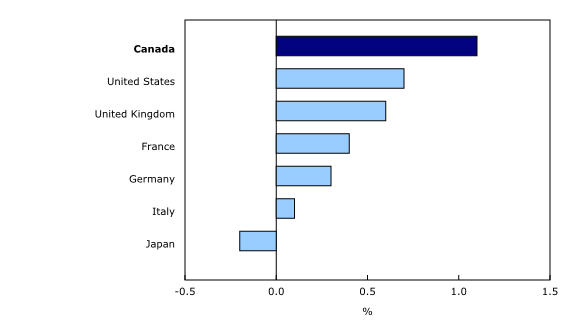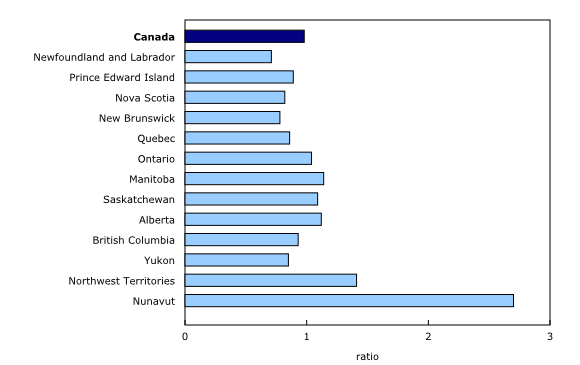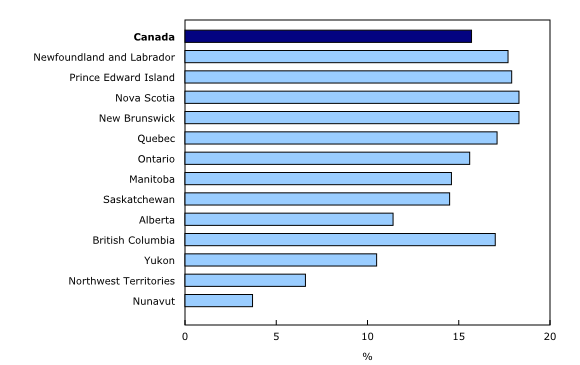Canada's population estimates: Age and sex, 2014
Archived Content
Information identified as archived is provided for reference, research or recordkeeping purposes. It is not subject to the Government of Canada Web Standards and has not been altered or updated since it was archived. Please "contact us" to request a format other than those available.
Released: 2014-09-26
On July 1, 2014, Canada's population was estimated at 35,540,400, up 386,100 or 1.1% over the last year (2013/2014). This increase was slightly lower than that of the previous year (+1.2% in 2012/2013) but similar to the average annual population increase for the last 30 years (+1.1%).
Except for the period between 1986/1987 and 1989/1990, when rates were higher, the overall population growth rate has shown little variation in 30 years, ranging between 0.8% and 1.2%.
Canada's population growth is the highest among G7 countries
For the most recent comparable annual period (see the note to readers), Canada's population growth rate (+1.1%) was the highest among the G7 countries, exceeding that of the United States (+0.7%), the United Kingdom (+0.6%), France (+0.4%), Germany (+0.3%), Italy (+0.1%) and Japan (-0.2%).
Canada's population growth rate was not, however, the highest among industrialized countries; for example, it was lower than the rates recorded in Australia (+1.7%), New Zealand (+1.5%) and Switzerland (+1.2%).
Population growth remains higher in the Prairie provinces and Nunavut
Population growth varied among the provinces and territories. Growth was above the national level (+1.1%) in Nunavut (+3.2%), Alberta (+2.8%), Saskatchewan (+1.7%) and Manitoba (+1.3%). Population growth changed from positive in 2012/2013 to negative in 2013/2014 in the Northwest Territories (from +0.5% to -0.5%) and Newfoundland and Labrador (from +0.3% to -0.2%).
On the other hand, growth increased markedly in Nunavut (from +2.0% to +3.2%) and Prince Edward Island (from +0.2% to +0.5%) in 2013/2014 compared with the previous year.
Population growth mainly driven by international migration
In 2013/2014, net international migration accounted for almost two-thirds (66.5%) of the total increase in Canada's population. At the provincial level, net international migration was also the main factor in population growth for Prince Edward Island, Quebec, Ontario, Manitoba, Saskatchewan, Alberta and British Columbia.
Natural increase played a major part in the territories, whether by partially offsetting the losses from interprovincial migration, as in the Northwest Territories, or by contributing to population increase, as in Nunavut.
In contrast, natural increase remained fairly low in the Atlantic provinces and was negative in Newfoundland and Labrador for a second year in a row.
In the last 30 years, Eastern Canada's population share has decreased, while Western Canada's has increased
On July 1, 2014, more than 85% of Canadians lived in four provinces: Ontario (38.5%), Quebec (23.1%), British Columbia (13.0%) and Alberta (11.6%).
The population share of each province and territory has evolved differently over time. Since 1984, the population share of the Atlantic provinces has decreased by 2.3 percentage points, while that of the western provinces has increased by 2.4 percentage points.
Over the same period, population shares increased in three provinces: Ontario (+2.7 percentage points), Alberta (+2.2 percentage points) and British Columbia (+1.5 percentage point). Of all the provinces, Quebec's population share decreased the most (-2.8 percentage points), reaching 23.1% as of July 1, 2014.
Baby boomers accelerate Canada's population aging
On July 1, 2014, 15.7% of Canada's population (nearly one in six Canadians) was aged 65 and older. This proportion has steadily increased since the mid-1960s as a result of lower fertility levels and longer life expectancy.
Thirty years earlier, the proportion of Canadians aged 65 and older was 10.0%. The growth of this age group has accelerated since the beginning of the current decade, more precisely in 2011, when the first baby boomers started to turn 65.
According to the most recent population projections, by the year 2016, the number of seniors aged 65 and older would be greater than the number of children under the age of 15. Furthermore, seniors would account for between 24% and 28% of the population by the year 2063, almost 50 years from now.
The proportion of people aged 55 to 64 now exceeds that of those aged 15 to 24
Population estimates show, for the first time, that there are more Canadians aged 55 to 64—the age when people typically leave the labour force—than there are Canadians aged 15 to 24—the age when people typically enter the labour force. On July 1, 2014, there were 4.6 million people aged 15 to 24 in Canada, compared with 4.7 million people aged 55 to 64. Thirty years ago, for every person aged 55 to 64, there were two people aged 15 to 24; this ratio has now fallen by half to just below 1.
On July 1, 2014, the ratio of people aged 15 to 24 to people aged 55 to 64 remained above 1 in four provinces: Manitoba (1.14), Alberta (1.12), Saskatchewan (1.09) and Ontario (1.04). The ratio was below 1 in British Columbia (0.93), Quebec (0.86), Yukon (0.85) and in each of the Atlantic provinces, reaching its lowest value in Newfoundland and Labrador (0.71).
The population is older in the Atlantic provinces and younger in the territories
The extent of population aging is not the same across the country. The proportion of people aged 65 and older was highest in the Atlantic provinces and lowest in the territories. Among the provinces, the highest proportions of seniors were in New Brunswick and Nova Scotia (18.3% in both cases), while Alberta (11.4%) recorded the lowest. The nation's youngest population lived in Nunavut, where seniors made up 3.7% of the population.
Population aging is faster in Newfoundland and Labrador and slower in Saskatchewan
During the last 30 years, the proportion of seniors aged 65 years and older increased in all provinces and territories. The pace of population aging, however, was not uniform across Canada.
Population aging was most rapid in Newfoundland and Labrador, where the proportion of people aged 65 and older rose by 9.5 percentage points (from 8.2% to 17.7%) between 1984 and 2014. Population aging was also rapid in New Brunswick and Quebec (+7.8 percentage points for each province) over the last 30 years. In contrast, Saskatchewan was the province with the lowest proportional increase in seniors (+2.2 percentage points).
Canada–United States comparison
A comparison of the demographic indicators for Canada's provinces and territories with those of the 50 American states (see the note to readers) can provide a better understanding of Canada's diverse population portrait. Certain provinces and territories are either the fastest growing or the slowest growing among regions in Canada and the United States.
Of all states, provinces and territories, Nunavut registered the largest annual growth, at 3.2%. It was followed by North Dakota (+3.1%) and Alberta (+2.8%), two regions associated with economic activity related to oil and gas extraction.
On the other hand, the populations of the Northwest Territories (-0.5%), Newfoundland and Labrador (-0.2%), New Brunswick (-0.2%) and West Virginia (-0.1%) registered the largest population decreases.
In terms of the proportion of people aged 65 and older, the four Atlantic provinces were among the oldest regions in Canada and the United States: only Florida (18.7%) had a higher proportion of seniors. In addition, the proportion of people aged 65 and older was also high in Quebec (17.1%) and British Columbia (17.0%), these provinces being surpassed by the Atlantic provinces, Florida and two other states: Maine (17.7%) and West Virginia (17.3%).
At the opposite end of the spectrum, Nunavut (3.7%) and the Northwest Territories (6.6%) were the regions with the lowest proportions of seniors aged 65 and older in Canada and the United States. Among the provinces, the youngest population was in Alberta (11.4%), its proportion of seniors being lower than that of all states except three: Alaska (9.3%), Utah (9.8%) and Texas (11.3%).
Note to readers
Estimates by age and sex in this release are based on 2011 Census counts adjusted for census net undercoverage and incompletely enumerated Indian reserves, to which is added the estimated demographic growth from May 10, 2011 to June 30, 2014.
This release focuses mainly on preliminary postcensal population estimates by age and sex as of July 1, 2014. The estimates presented in this release are subject to revision. Future updates could affect the trends observed and analyzed in this release.
Population growth rates are calculated using the average of populations at the beginning and end of the period under consideration as a denominator. A rate that is higher than -0.1% but lower than 0.1% is considered not to be significant.
The population share of a province or territory refers to the proportion of its population among the total population of Canada.
G7 is an informal discussion group and economic partnership consisting of seven countries: the United States, Japan, Germany, France, the United Kingdom, Italy and Canada.
International population estimates and growth rates
Data used for international comparisons are for comparable periods and are taken from Eurostat and the national statistical agencies of the following countries: the United States, Japan, Italy, Australia and New Zealand.
To calculate the population growth rate of Canada, the period considered was from July 1, 2013 to June 30, 2014. For Germany, France, Italy, Switzerland, the United Kingdom and Australia, the period considered was from January 1, 2013 to December 31, 2013. For the United States, the period considered was from July 1, 2012 to June 30, 2013. For Japan, the period considered was from October 1, 2012 to September 30, 2013. For New Zealand, the period considered was from July 1, 2013 to June 30, 2014.
Italy's population growth rate rose to 1.8% in 2013 and differed markedly from the lower growth observed during the previous years. The strong growth rate was essentially due to revisions made to municipal population registers. For this international comparison, the population growth rate based solely on demographic factors (+0.1%) was used, rather than the rate that reflected the special revision.
To calculate the population growth rates of Canada's provinces and territories, the period considered was from July 1, 2013 to June 30, 2014. For the US states, the period considered was from July 1, 2012 to June 30, 2013.
To calculate the proportion of people aged 65 and older among the total population, the data for the United States as of July 1, 2013, were used for the comparative analysis, as they were the most recent data available.
The Annual Demographic Estimates: Canada, Provinces and Territories, 2014, no. 2 (Catalogue number91-215-X), is now available from the Browse by key resource module of our website under Publications.
The Quarterly Demographic Estimates, Vol. 28, no. 2 (Catalogue number91-002-X), is also available from the Browse by key resource module of our website under Publications.
Contact information
For more information, or to enquire about the concepts, methods or data quality of this release, contact us (toll-free 1-800-263-1136; 514-283-8300; infostats@statcan.gc.ca) or Media Relations (613-951-4636; statcan.mediahotline-ligneinfomedias.statcan@canada.ca).
- Date modified:







